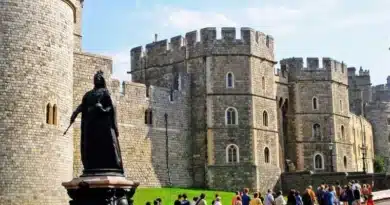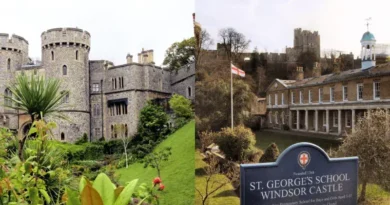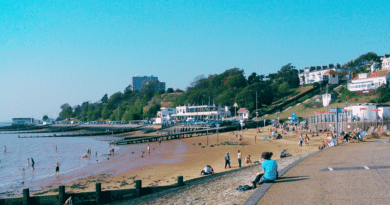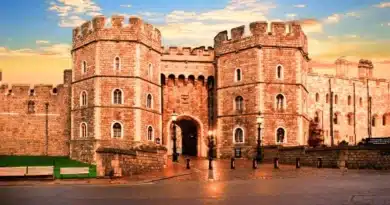The Windsor Castle Dogs
Key Takeaways
| Key Takeaways | Details |
|---|---|
| A Legacy of Canine Companionship | The Windsor Castle dogs embody a centuries-long tradition of loyalty, companionship, and the connection between the British monarchy and their canine companions. |
| Evolution of Royal Dogs’ Roles | – Early dogs served as hunting companions and for security. – By the 16th century, dogs became symbols of status and affection within the royal household. – Different monarchs favoured various breeds, reflecting personal preferences and cultural trends. |
| Iconic Breeds and Stories | – Queen Victoria introduced exotic breeds like the Pekingese and established the royal kennels at Windsor Castle. – King Edward VII adored terriers, with Jack (an Irish Terrier) symbolizing goodwill. – Queen Elizabeth II’s lifelong love for Pembroke Welsh Corgis, notably Susan and Willow, who accompanied her throughout her reign. |
| Royal Kennels and Dog Care | – The well-being of royal dogs was ensured through dedicated facilities and staff. – Historical records highlight the meticulous care and structured lifestyle provided to these animals. |
| Royal Dogs in Public Life | – Participated in official ceremonies, symbolizing continuity and adding a personal touch. – Appearances in portraits and family gatherings. – Queen Elizabeth II’s corgis, Muick and Sandy, attended her funeral as a touching tribute. |
| Modern-Day Royal Dogs | – The tradition continues with King Charles III and Queen Camilla’s Jack Russell Terriers. – Other royal family members embrace various breeds, maintaining the enduring bond between humans and their canine companions. |
| Visitor Information | |
| Dogs at Windsor Castle | – Early dogs served as hunting companions and for security. – By the 16th century, dogs became symbols of status and affection within the royal household. – Different monarchs favoured various breeds, reflecting personal preferences and cultural trends. |
| Dogs in Windsor Great Park | – Well-behaved dogs are welcome in Windsor Great Park (separate from castle grounds). – Various trails are available, but dogs should be controlled, and owners must clean up after them. – Picnics with dogs are allowed in the park. |
| Dog-Friendly Amenities | – Many pubs in Windsor allow dogs in their gardens (check policies beforehand). – Some nearby hotels offer dog-friendly rooms (verify pet policies). – Windsor town may have dog crèches or boarding facilities. – Dog-friendly cafes and shops are available in Windsor (check individual policies). |
| Viewing the Changing of the Guard | You can watch the guards march to the castle from the streets of Windsor with your dog, but dogs are not allowed inside the castle for the actual ceremony. |
| Photography | You can take photos with your dog outside Windsor Castle (e.g., near the King Henry VIII Gateway), but photography is restricted inside the castle itself. |
| Royal Dog History | The Royal Family has a long history of keeping dogs at Windsor Castle, such as Queen Victoria’s spaniel, Dash, and Queen Elizabeth II’s beloved corgis. |
Introduction
Windsor Castle, an enduring symbol of British royalty, has been a residence for monarchs and a cherished haven for their beloved canine companions. The castle’s long history intertwines with tales of dogs that have offered comfort, loyalty, and joy to the royal family. Dogs at Windsor Castle have held more than a mere decorative or domestic role; they have been integral members of the royal household. This article explores the historical significance and fascinating stories of the Windsor Castle dogs.

Historical Overview of Royal Dogs at Windsor Castle
Early Records of Royal Dogs at Windsor
The bond between the British monarchy and dogs dates back to the medieval era. Early records depict dogs as essential members of court life, serving in hunting, security, and companionship. During the reign of King Edward III, greyhounds were celebrated for their hunting prowess, often accompanying monarchs during hunts in Windsor Great Park. These early depictions laid the groundwork for a centuries-long tradition of canine companionship at Windsor Castle.
Evolution of Canine Companionship in the Royal Household
By the 16th century, the role of dogs within the royal family began to shift. Rather than serving primarily as working animals, dogs increasingly became symbols of status and affection. The Tudor period saw breeds such as spaniels and mastiffs become fashionable among the aristocracy. Under successive monarchs, Windsor Castle became an epicentre for this evolving relationship, with its vast grounds offering an ideal space for royal dogs to thrive.

Queen Victoria’s Canine Companions
Introduction of New Breeds, Such as the Pekingese
Queen Victoria, known for her love of animals, played a pivotal role in popularizing numerous dog breeds in Britain. During her reign, she introduced exotic breeds to the royal household, one of the most notable being the Pekingese. Her fascination with these small, lion-like dogs reflected her appreciation for cultural diversity and unique animals.
The Story of Looty, the First Pekingese in Britain
Looty, the first Pekingese dog in Britain, arrived due to the British invasion of the Old Summer Palace in Beijing in 1860. Captain John Hart Dunne presented the dog to Queen Victoria, who named her Looty as a reference to the circumstances of her acquisition. Looty’s exotic appearance and charming demeanour captivated the Queen and sparked widespread interest in the breed across Britain.
Establishment of the Royal Kennels
Queen Victoria oversaw the expansion of the royal kennels at Windsor Castle to accommodate her growing collection of dogs. These facilities were meticulously maintained and were a testament to the Queen’s devotion to her pets. The kennels housed Pekingese, dachshunds, collies, and King Charles Spaniels, reflecting the Queen’s diverse preferences.

King Edward VII and His Terriers
Preference for Terrier Breeds
King Edward VII inherited his mother’s affection for dogs but displayed a fondness for terriers. Known for their spirited personalities and loyalty, terriers were a natural choice for the King, who valued their companionship during both public and private moments.
Notable Dogs, Including Irish Terrier Jack
One of King Edward VII’s most famous canine companions was Jack, an Irish Terrier. Jack’s loyalty and charm made him a favourite not only of the King but also of the public. During the King’s visit to Ireland in 1903, Jack accompanied him and became a symbol of goodwill. After Jack’s passing, he was honoured with a burial at Áras an Uachtaráin, underscoring the depth of the bond between the King and his beloved terrier.

Queen Elizabeth II and Her Beloved Corgis
Introduction to the Pembroke Welsh Corgis
Queen Elizabeth II’s association with Pembroke Welsh Corgis is perhaps the most iconic of any royal canine relationship. Her love for the breed began in childhood when her father, King George VI, brought home a corgi named Dookie. This early introduction sparked a lifelong affection for the breed, defining the Queen’s public and private life.
Role of Corgis During World War II at Windsor Castle
During World War II, Windsor Castle served as a refuge for Princess Elizabeth and Princess Margaret. The presence of their corgis provided emotional support during these challenging times. The dogs were not merely pets but integral members of the royal family, offering comfort amid the uncertainties of war.
Notable Corgis Over the Years
Over her reign, Queen Elizabeth II owned more than 30 corgis, each with its own unique personality and story. Notable among them was Susan, who accompanied the Queen on her honeymoon in 1947 and became the matriarch of a long line of royal corgis. Another famous corgi, Willow, appeared in a James Bond sketch for the 2012 London Olympics, showcasing the breed’s role in the Queen’s public persona.

The Royal Kennels at Windsor Castle
Design and Facilities of the Kennels
The royal kennels at Windsor Castle were designed with great care to provide comfort and functionality. Spacious exercise areas, grooming stations, and comfortable sleeping quarters ensured the well-being of the royal dogs. These facilities reflected the royal family’s commitment to their canine companions.
Daily Routines and Care of the Royal Dogs
The care of the royal dogs was entrusted to a dedicated team of staff who managed their feeding, grooming, and exercise routines. Each dog was given individual attention, ensuring they remained healthy and content. The structured lifestyle of these animals mirrored the discipline and care characteristic of the royal household.
Historical Accounts of the Kennels in the 19th and Early 20th Centuries
Historical records from the 19th and early 20th centuries provide fascinating insights into the operation of the royal kennels. An article from 1902 describes the meticulous care provided to the dogs, highlighting the importance placed on their Well-being within the royal household.
Royal Dogs in Ceremonial Roles
Presence During Official Events and Ceremonies
Royal dogs have often played a role in official ceremonies, adding a personal touch to state occasions. Their presence symbolizes continuity and the enduring bond between the monarchy and its people.
Notable Appearances, Such as During Queen Elizabeth II’s Funeral
One of the most poignant examples of royal dogs participating in ceremonies was during Queen Elizabeth II’s funeral in 2022. Her beloved corgis, Muick and Sandy, were present at Windsor Castle as the Queen’s coffin arrived, offering a touching tribute to their owner.

Artistic Depictions of Windsor Castle Dogs
Paintings and Photographs in the Royal Collection
The royal dogs have been immortalized in numerous artworks and photographs over the centuries. Paintings in the Royal Collection depict dogs alongside their royal owners, capturing their personalities and the bond they shared.
Famous Artworks Featuring the Royal Dogs
Artists like Sir Edwin Landseer, known for his animal portraits, have celebrated the royal dogs in their work. These pieces showcase the animals and reflect the cultural significance of dogs within the royal household.

Modern-Day Royal Dogs at Windsor
Current Royal Family Members and Their Canine Companions
Today, the royal family continues to maintain a strong connection with dogs. King Charles III and Queen Camilla are known for their love of Jack Russell Terriers. At the same time, other family members have embraced different breeds, reflecting their individual personalities.
Recent Events Involving the Royal Dogs
In recent years, the royal dogs have continued to capture public attention. From their appearances in official portraits to their roles in family gatherings, these animals remain a cherished part of the royal household.

Conclusion
The Windsor Castle dogs represent a legacy of loyalty, companionship, and tradition. Their stories, spanning centuries, highlight the enduring bond between the British monarchy and their canine companions. From the early days of hunting greyhounds to Queen Elizabeth II’s iconic corgis, the royal dogs have left an indelible mark on the history of Windsor Castle. As the monarchy evolves, the presence of these beloved animals continues to symbolize the timeless values of love and loyalty.
FAQ
Are dogs allowed inside Windsor Castle?
Only assistance dogs are permitted within Windsor Castle. Pet dogs are not allowed inside the castle grounds.
Can I bring my dog to Windsor Great Park?
Yes, well-behaved dogs are welcome in Windsor Great Park, which offers a variety of trails through lakes, forests, and fields.
Where can I walk my dog near Windsor Castle?
Windsor Great Park is ideal for dog walking, providing extensive open spaces and quality trails.
Are there dog-friendly pubs near Windsor Castle?
Many pubs in the Windsor area allow dogs in their garden areas. It’s advisable to check with the establishment before visiting.
Is there a history of royal dogs at Windsor Castle?
Yes, the Royal Family has a long history of keeping dogs at Windsor Castle, notably Queen Victoria’s spaniel, Dash, buried on the grounds.
Did Queen Elizabeth II keep corgis at Windsor Castle?
Yes, Queen Elizabeth II was known for her love of corgis, often keeping them at her residences, including Windsor Castle.
Are there any dog-friendly hotels near Windsor Castle?
Yes, some hotels near Windsor Castle offer dog-friendly rooms. Checking with the hotel regarding their pet policy before booking is recommended.
Can I see the Changing of the Guard with my dog?
While the actual ceremony occurs inside the castle, you can watch the guards march to the castle from the streets of Windsor with your dog.
Are there any dog-friendly events at Windsor Castle?
Windsor Castle itself does not host dog-friendly events. Still, the surrounding areas, such as Windsor Great Park, may have events suitable for dogs. Check local listings for details.
Is there a designated area for dogs in Windsor Great Park?
While there isn’t a specific dog area, Windsor Great Park offers numerous trails and open spaces where dogs can be walked. Owners should ensure dogs are well-behaved and under control.
Are there any restrictions for dogs in Windsor Great Park?
Dogs should be controlled; owners are expected to clean up after their pets. Specific areas may have additional guidelines, so observing local signage is advisable.
Can I picnic with my dog near Windsor Castle?
Yes, picnicking with your dog is possible in areas like Windsor Great Park. Ensure you follow park guidelines and clean up after your pet.
Are there any dog-friendly attractions near Windsor Castle?
Beyond Windsor Great Park, the surrounding town offers dog-friendly cafes and shops. It’s best to check individual policies before visiting.
Is there a dog crèche near Windsor Castle?
While Windsor Castle doesn’t offer dog-sitting services, the town of Windsor may have local dog crèches or boarding facilities. Researching and contacting them in advance is recommended.
Can I take photos of my dog outside Windsor Castle?
Yes, you can take photos with your dog outside the castle, such as near the King Henry VIII Gateway on Castle Hill. However, photography inside the castle is restricted.









